2007 ISUZU KB P190 check transmission fluid
[x] Cancel search: check transmission fluidPage 4370 of 6020
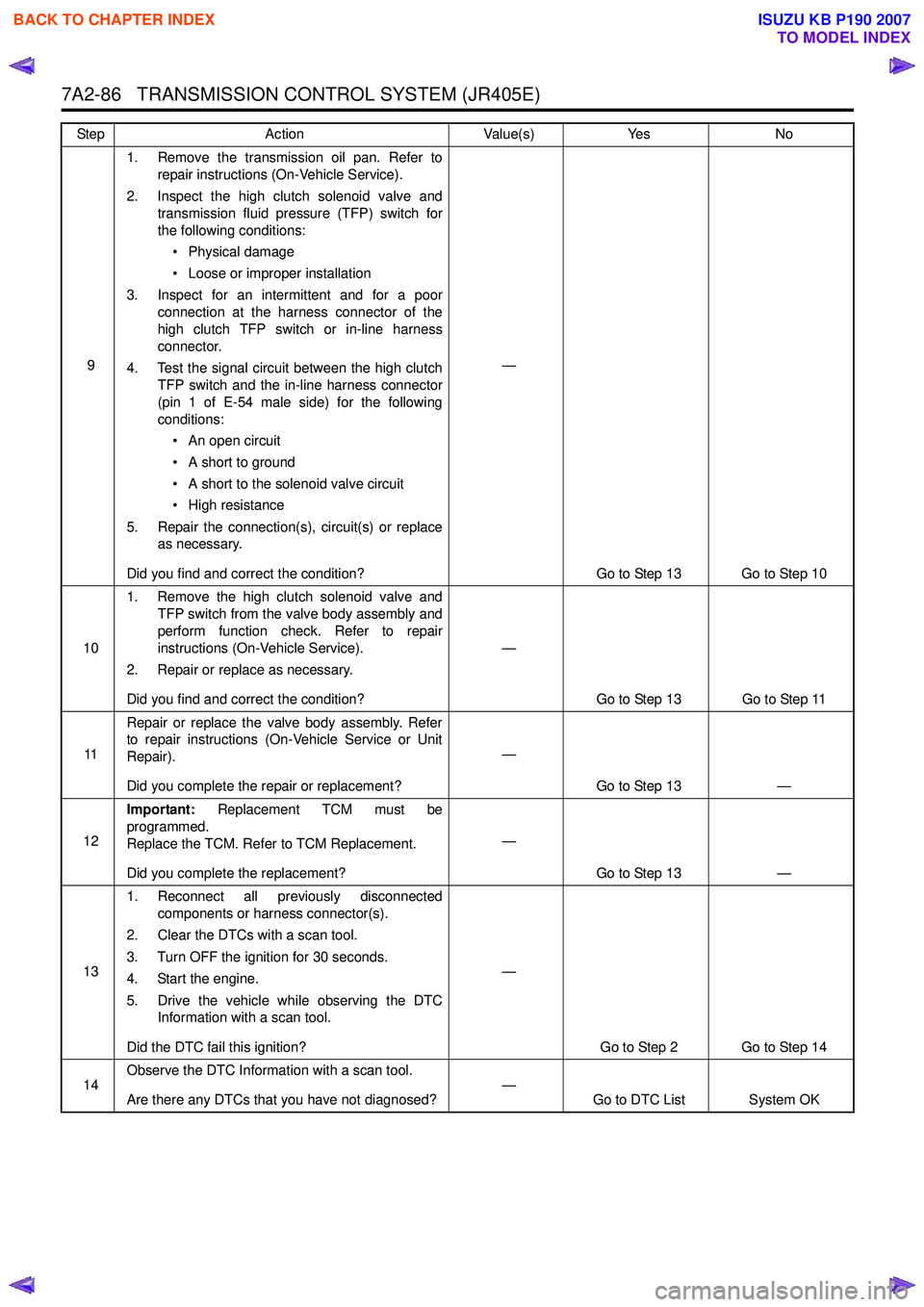
7A2-86 TRANSMISSION CONTROL SYSTEM (JR405E)
91. Remove the transmission oil pan. Refer to
repair instructions (On-Vehicle Service).
2. Inspect the high clutch solenoid valve and transmission fluid pressure (TFP) switch for
the following conditions:
• Physical damage
• Loose or improper installation
3. Inspect for an intermittent and for a poor connection at the harness connector of the
high clutch TFP switch or in-line harness
connector.
4. Test the signal circuit between the high clutch TFP switch and the in-line harness connector
(pin 1 of E-54 male side) for the following
conditions:
• An open circuit
• A short to ground
• A short to the solenoid valve circuit
• High resistance
5. Repair the connection(s), circuit(s) or replace as necessary.
Did you find and correct the condition? —
Go to Step 13 Go to Step 10
10 1. Remove the high clutch solenoid valve and
TFP switch from the valve body assembly and
perform function check. Refer to repair
instructions (On-Vehicle Service).
2. Repair or replace as necessary.
Did you find and correct the condition? —
Go to Step 13 Go to Step 11
11 Repair or replace the valve body assembly. Refer
to repair instructions (On-Vehicle Service or Unit
Repair).
Did you complete the repair or replacement? —
Go to Step 13 —
12 Important:
Replacement TCM must be
programmed.
Replace the TCM. Refer to TCM Replacement.
Did you complete the replacement? —
Go to Step 13 —
13 1. Reconnect all previously disconnected
components or harness connector(s).
2. Clear the DTCs with a scan tool.
3. Turn OFF the ignition for 30 seconds.
4. Start the engine.
5. Drive the vehicle while observing the DTC Information with a scan tool.
Did the DTC fail this ignition? —
Go to Step 2 Go to Step 14
14 Observe the DTC Information with a scan tool.
Are there any DTCs that you have not diagnosed? —
Go to DTC List System OK
Step
Action Value(s)Yes No
BACK TO CHAPTER INDEX
TO MODEL INDEX
ISUZU KB P190 2007
Page 4376 of 6020
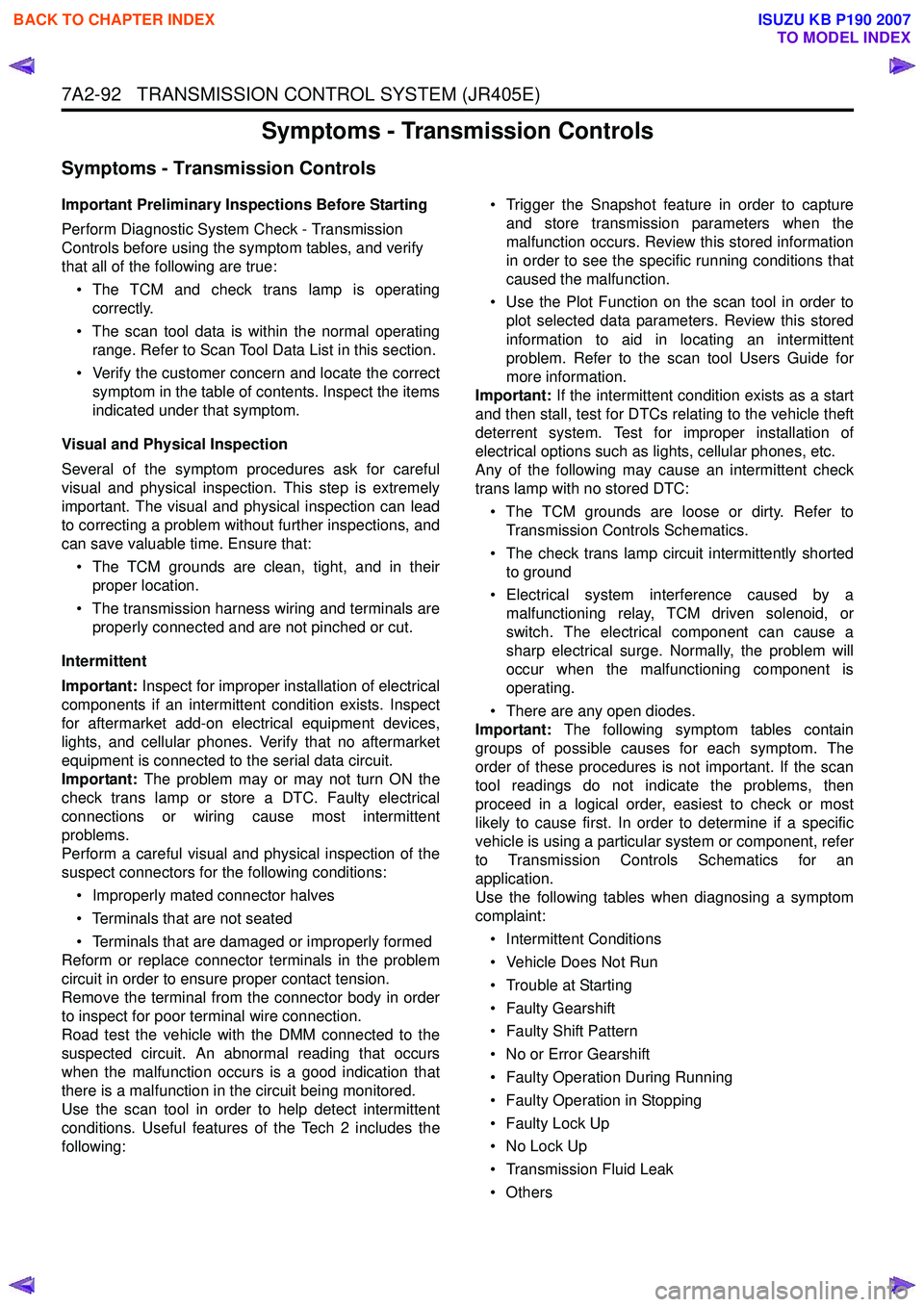
7A2-92 TRANSMISSION CONTROL SYSTEM (JR405E)
Symptoms - Transmission Controls
Symptoms - Transmission Controls
Important Preliminary Inspections Before Starting
Perform Diagnostic System Check - Transmission
Controls before using the symptom tables, and verify
that all of the following are true:
• The TCM and check trans lamp is operating correctly.
• The scan tool data is within the normal operating range. Refer to Scan Tool Data List in this section.
• Verify the customer concern and locate the correct symptom in the table of contents. Inspect the items
indicated under that symptom.
Visual and Physical Inspection
Several of the symptom procedures ask for careful
visual and physical inspection. This step is extremely
important. The visual and physical inspection can lead
to correcting a problem without further inspections, and
can save valuable time. Ensure that:
• The TCM grounds are clean, tight, and in their proper location.
• The transmission harness wiring and terminals are properly connected and are not pinched or cut.
Intermittent
Important: Inspect for improper installation of electrical
components if an intermittent condition exists. Inspect
for aftermarket add-on electrical equipment devices,
lights, and cellular phones. Verify that no aftermarket
equipment is connected to the serial data circuit.
Important: The problem may or may not turn ON the
check trans lamp or store a DTC. Faulty electrical
connections or wiring cause most intermittent
problems.
Perform a careful visual and physical inspection of the
suspect connectors for the following conditions:
• Improperly mated connector halves
• Terminals that are not seated
• Terminals that are damaged or improperly formed
Reform or replace connector terminals in the problem
circuit in order to ensure proper contact tension.
Remove the terminal from the connector body in order
to inspect for poor terminal wire connection.
Road test the vehicle with the DMM connected to the
suspected circuit. An abnormal reading that occurs
when the malfunction occurs is a good indication that
there is a malfunction in the circuit being monitored.
Use the scan tool in order to help detect intermittent
conditions. Useful features of the Tech 2 includes the
following: • Trigger the Snapshot feature in order to capture
and store transmission parameters when the
malfunction occurs. Review this stored information
in order to see the specific running conditions that
caused the malfunction.
• Use the Plot Function on the scan tool in order to plot selected data parameters. Review this stored
information to aid in locating an intermittent
problem. Refer to the scan tool Users Guide for
more information.
Important: If the intermittent condition exists as a start
and then stall, test for DTCs relating to the vehicle theft
deterrent system. Test for improper installation of
electrical options such as lights, cellular phones, etc.
Any of the following may cause an intermittent check
trans lamp with no stored DTC:
• The TCM grounds are loose or dirty. Refer to Transmission Controls Schematics.
• The check trans lamp circuit intermittently shorted to ground
• Electrical system interference caused by a malfunctioning relay, TCM driven solenoid, or
switch. The electrical component can cause a
sharp electrical surge. Normally, the problem will
occur when the malfunctioning component is
operating.
• There are any open diodes.
Important: The following symptom tables contain
groups of possible causes for each symptom. The
order of these procedures is not important. If the scan
tool readings do not indicate the problems, then
proceed in a logical order, easiest to check or most
likely to cause first. In order to determine if a specific
vehicle is using a particular system or component, refer
to Transmission Controls Schematics for an
application.
Use the following tables when diagnosing a symptom
complaint:
• Intermittent Conditions
• Vehicle Does Not Run
• Trouble at Starting
• Faulty Gearshift
• Faulty Shift Pattern
• No or Error Gearshift
• Faulty Operation During Running
• Faulty Operation in Stopping
• Faulty Lock Up
• No Lock Up
• Transmission Fluid Leak
•Others
BACK TO CHAPTER INDEX
TO MODEL INDEX
ISUZU KB P190 2007
Page 4386 of 6020
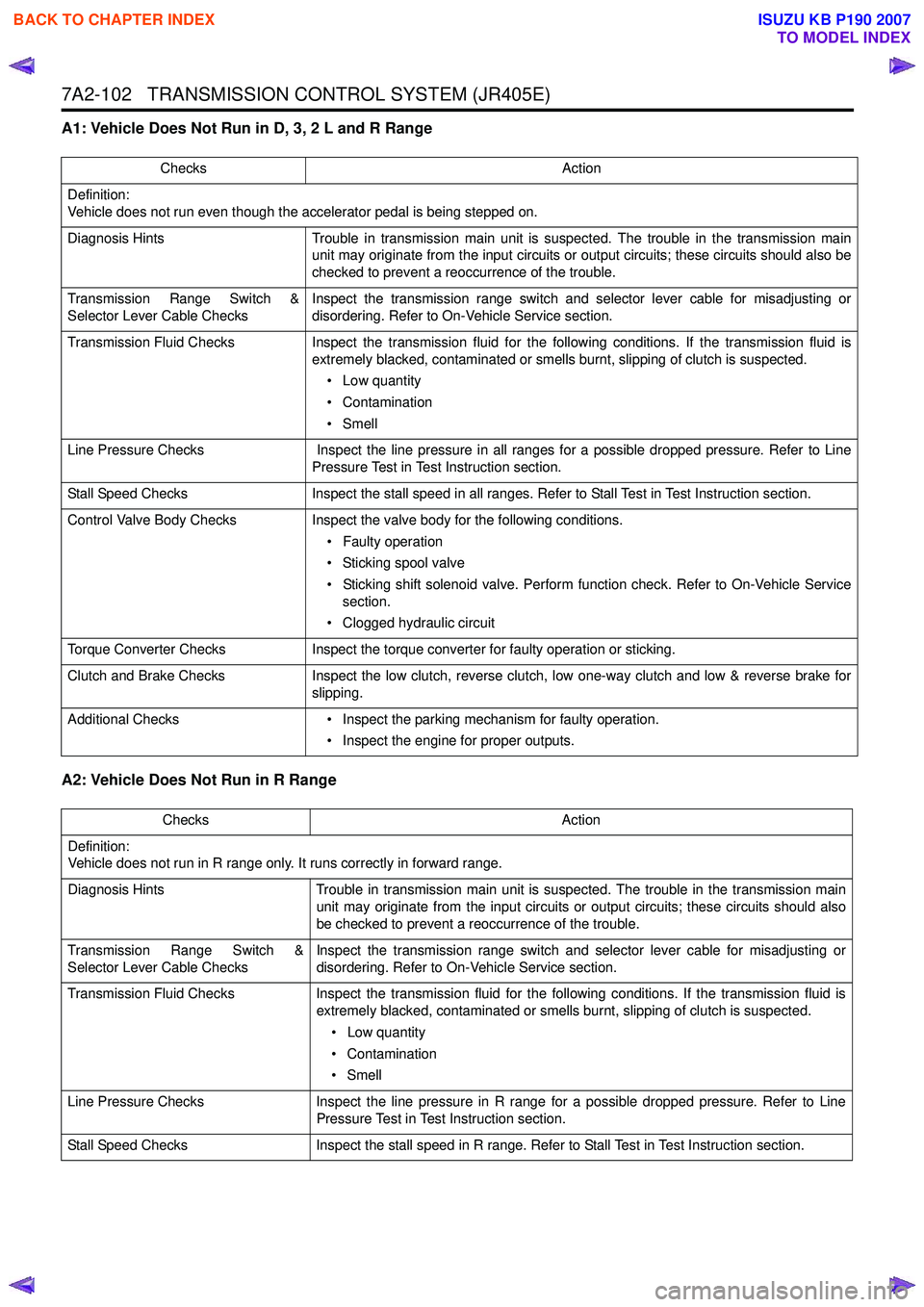
7A2-102 TRANSMISSION CONTROL SYSTEM (JR405E)
A1: Vehicle Does Not Run in D, 3, 2 L and R Range
A2: Vehicle Does Not Run in R Range
ChecksAction
Definition:
Vehicle does not run even though the accelerator pedal is being stepped on.
Diagnosis Hints Trouble in transmission main unit is suspected. The trouble in the transmission main
unit may originate from the input circuits or output circuits; these circuits should also be
checked to prevent a reoccurrence of the trouble.
Transmission Range Switch &
Selector Lever Cable Checks Inspect the transmission range switch and selector lever cable for misadjusting or
disordering. Refer to On-Vehicle Service section.
Transmission Fluid Checks Inspect the transmission fluid for the following conditions. If the transmission fluid is
extremely blacked, contaminated or smells burnt, slipping of clutch is suspected.
• Low quantity
• Contamination
•Smell
Line Pressure Checks Inspect the line pressure in all ranges for a possible dropped pressure. Refer to Line
Pressure Test in Test Instruction section.
Stall Speed Checks Inspect the stall speed in all ranges. Refer to Stall Test in Test Instruction section.
Control Valve Body Checks Inspect the valve body for the following conditions.
• Faulty operation
• Sticking spool valve
• Sticking shift solenoid valve. Perform function check. Refer to On-Vehicle Service section.
• Clogged hydraulic circuit
Torque Converter Checks Inspect the torque converter for faulty operation or sticking.
Clutch and Brake Checks Inspect the low clutch, reverse clutch, low one-way clutch and low & reverse brake for
slipping.
Additional Checks • Inspect the parking mechanism for faulty operation.
• Inspect the engine for proper outputs.
Checks Action
Definition:
Vehicle does not run in R range only. It runs correctly in forward range.
Diagnosis Hints Trouble in transmission main unit is suspected. The trouble in the transmission main
unit may originate from the input circuits or output circuits; these circuits should also
be checked to prevent a reoccurrence of the trouble.
Transmission Range Switch &
Selector Lever Cable Checks Inspect the transmission range switch and selector lever cable for misadjusting or
disordering. Refer to On-Vehicle Service section.
Transmission Fluid Checks Inspect the transmission fluid for the following conditions. If the transmission fluid is
extremely blacked, contaminated or smells burnt, slipping of clutch is suspected.
• Low quantity
• Contamination
•Smell
Line Pressure Checks Inspect the line pressure in R range for a possible dropped pressure. Refer to Line
Pressure Test in Test Instruction section.
Stall Speed Checks Inspect the stall speed in R range. Refer to Stall Test in Test Instruction section.
BACK TO CHAPTER INDEX
TO MODEL INDEX
ISUZU KB P190 2007
Page 4387 of 6020
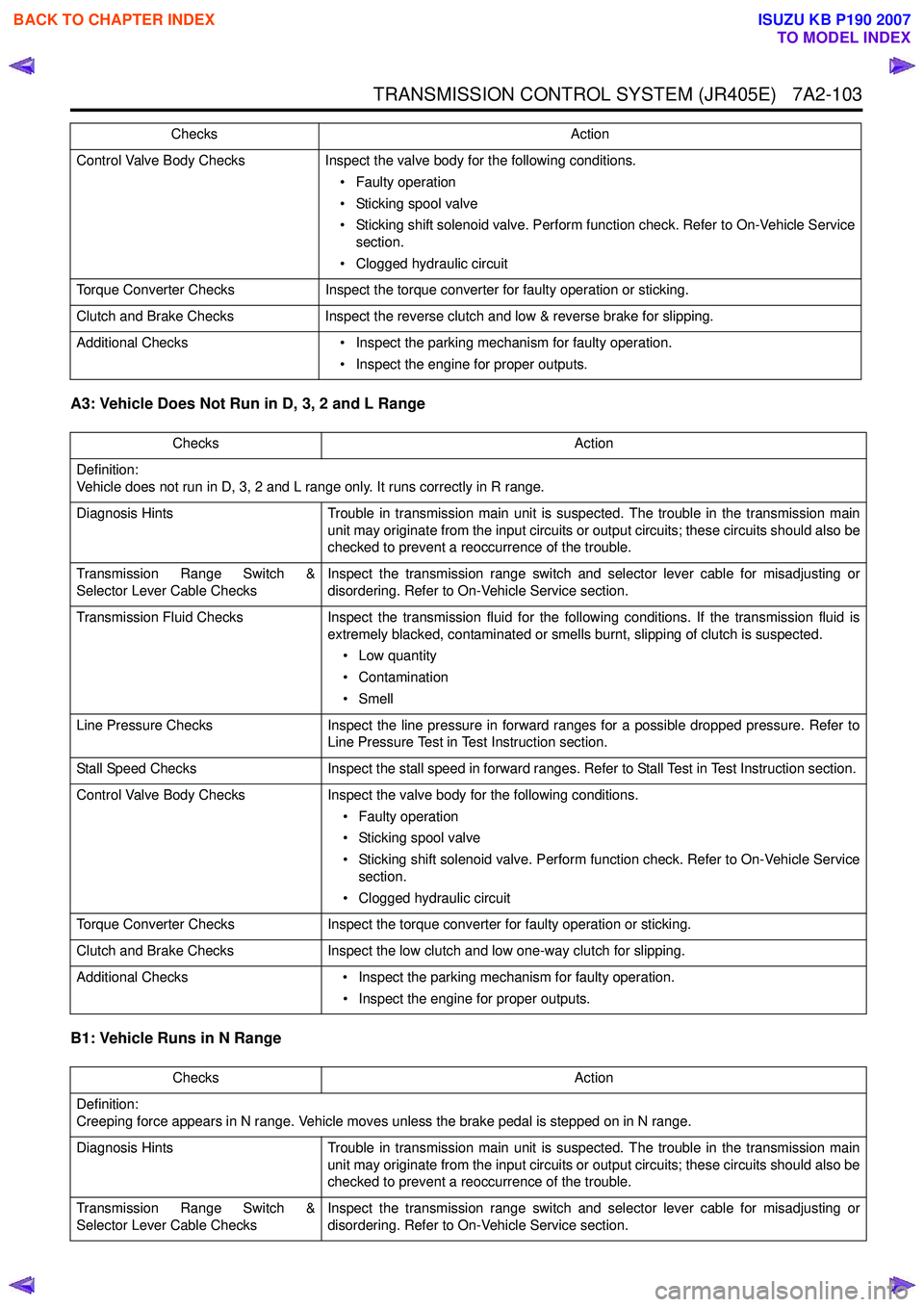
TRANSMISSION CONTROL SYSTEM (JR405E) 7A2-103
A3: Vehicle Does Not Run in D, 3, 2 and L Range
B1: Vehicle Runs in N Range
Control Valve Body Checks Inspect the valve body for the following conditions.
• Faulty operation
• Sticking spool valve
• Sticking shift solenoid valve. Perform function check. Refer to On-Vehicle Service section.
• Clogged hydraulic circuit
Torque Converter Checks Inspect the torque converter for faulty operation or sticking.
Clutch and Brake Checks Inspect the reverse clutch and low & reverse brake for slipping.
Additional Checks • Inspect the parking mechanism for faulty operation.
• Inspect the engine for proper outputs.
Checks
Action
Checks Action
Definition:
Vehicle does not run in D, 3, 2 and L range only. It runs correctly in R range.
Diagnosis Hints Trouble in transmission main unit is suspected. The trouble in the transmission main
unit may originate from the input circuits or output circuits; these circuits should also be
checked to prevent a reoccurrence of the trouble.
Transmission Range Switch &
Selector Lever Cable Checks Inspect the transmission range switch and selector lever cable for misadjusting or
disordering. Refer to On-Vehicle Service section.
Transmission Fluid Checks Inspect the transmission fluid for the following conditions. If the transmission fluid is
extremely blacked, contaminated or smells burnt, slipping of clutch is suspected.
• Low quantity
• Contamination
•Smell
Line Pressure Checks Inspect the line pressure in forward ranges for a possible dropped pressure. Refer to
Line Pressure Test in Test Instruction section.
Stall Speed Checks Inspect the stall speed in forward ranges. Refer to Stall Test in Test Instruction section.
Control Valve Body Checks Inspect the valve body for the following conditions.
• Faulty operation
• Sticking spool valve
• Sticking shift solenoid valve. Perform function check. Refer to On-Vehicle Service section.
• Clogged hydraulic circuit
Torque Converter Checks Inspect the torque converter for faulty operation or sticking.
Clutch and Brake Checks Inspect the low clutch and low one-way clutch for slipping.
Additional Checks • Inspect the parking mechanism for faulty operation.
• Inspect the engine for proper outputs.
Checks Action
Definition:
Creeping force appears in N range. Vehicle moves unless the brake pedal is stepped on in N range.
Diagnosis Hints Trouble in transmission main unit is suspected. The trouble in the transmission main
unit may originate from the input circuits or output circuits; these circuits should also be
checked to prevent a reoccurrence of the trouble.
Transmission Range Switch &
Selector Lever Cable Checks Inspect the transmission range switch and selector lever cable for misadjusting or
disordering. Refer to On-Vehicle Service section.
BACK TO CHAPTER INDEX
TO MODEL INDEX
ISUZU KB P190 2007
Page 4388 of 6020
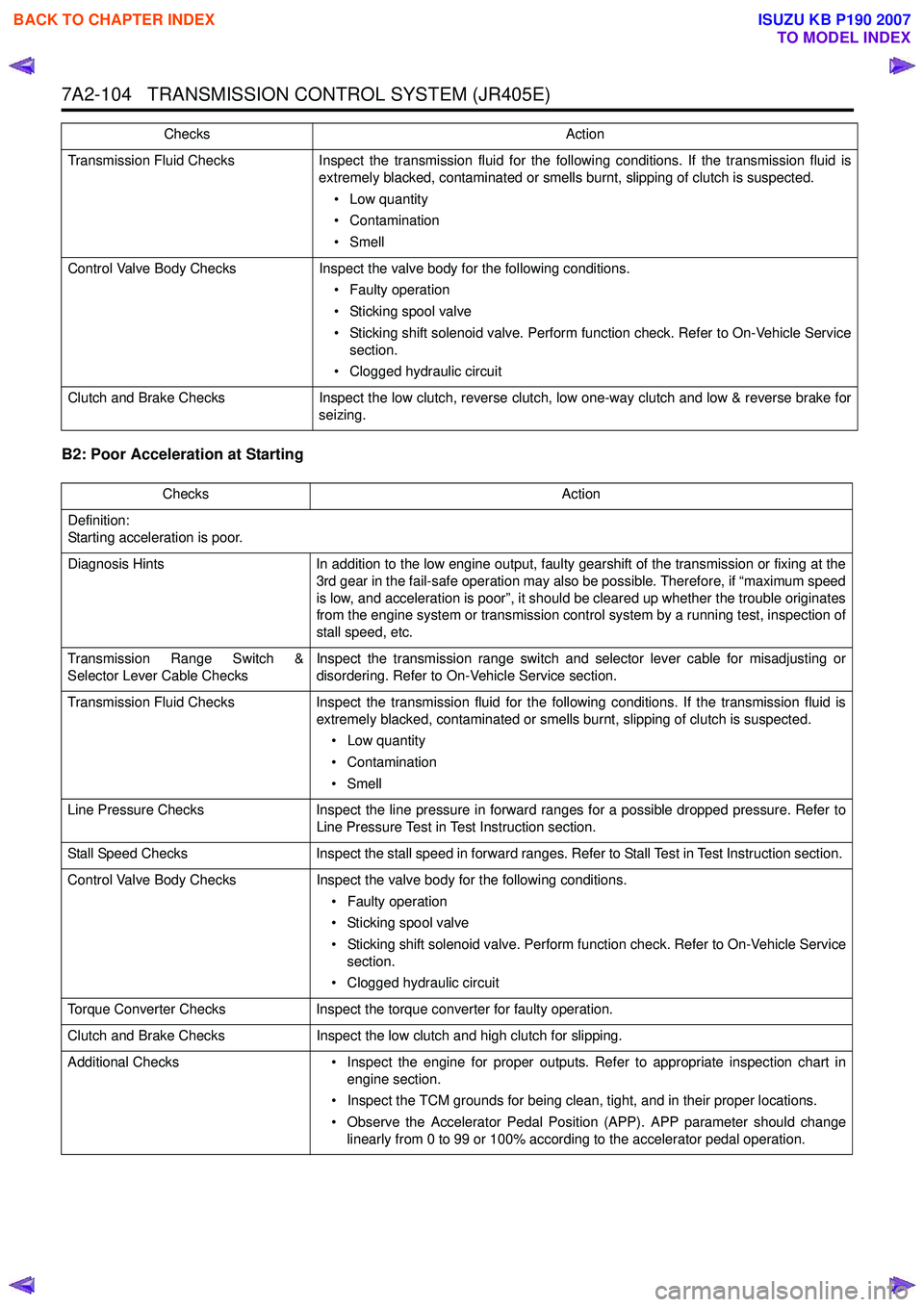
7A2-104 TRANSMISSION CONTROL SYSTEM (JR405E)
B2: Poor Acceleration at Starting
Transmission Fluid ChecksInspect the transmission fluid for the following conditions. If the transmission fluid is
extremely blacked, contaminated or smells burnt, slipping of clutch is suspected.
• Low quantity
• Contamination
•Smell
Control Valve Body Checks Inspect the valve body for the following conditions.
• Faulty operation
• Sticking spool valve
• Sticking shift solenoid valve. Perform function check. Refer to On-Vehicle Service section.
• Clogged hydraulic circuit
Clutch and Brake Checks Inspect the low clutch, reverse clutch, low one-way clutch and low & reverse brake for
seizing.
Checks
Action
ChecksAction
Definition:
Starting acceleration is poor.
Diagnosis Hints In addition to the low engine output, faulty gearshift of the transmission or fixing at the
3rd gear in the fail-safe operation may also be possible. Therefore, if “maximum speed
is low, and acceleration is poor”, it should be cleared up whether the trouble originates
from the engine system or transmission control system by a running test, inspection of
stall speed, etc.
Transmission Range Switch &
Selector Lever Cable Checks Inspect the transmission range switch and selector lever cable for misadjusting or
disordering. Refer to On-Vehicle Service section.
Transmission Fluid Checks Inspect the transmission fluid for the following conditions. If the transmission fluid is
extremely blacked, contaminated or smells burnt, slipping of clutch is suspected.
• Low quantity
• Contamination
•Smell
Line Pressure Checks Inspect the line pressure in forward ranges for a possible dropped pressure. Refer to
Line Pressure Test in Test Instruction section.
Stall Speed Checks Inspect the stall speed in forward ranges. Refer to Stall Test in Test Instruction section.
Control Valve Body Checks Inspect the valve body for the following conditions.
• Faulty operation
• Sticking spool valve
• Sticking shift solenoid valve. Perform function check. Refer to On-Vehicle Service section.
• Clogged hydraulic circuit
Torque Converter Checks Inspect the torque converter for faulty operation.
Clutch and Brake Checks Inspect the low clutch and high clutch for slipping.
Additional Checks • Inspect the engine for proper outputs. Refer to appropriate inspection chart in
engine section.
• Inspect the TCM grounds for being clean, tight, and in their proper locations.
• Observe the Accelerator Pedal Position (APP). APP parameter should change linearly from 0 to 99 or 100% according to the accelerator pedal operation.
BACK TO CHAPTER INDEX
TO MODEL INDEX
ISUZU KB P190 2007
Page 4389 of 6020
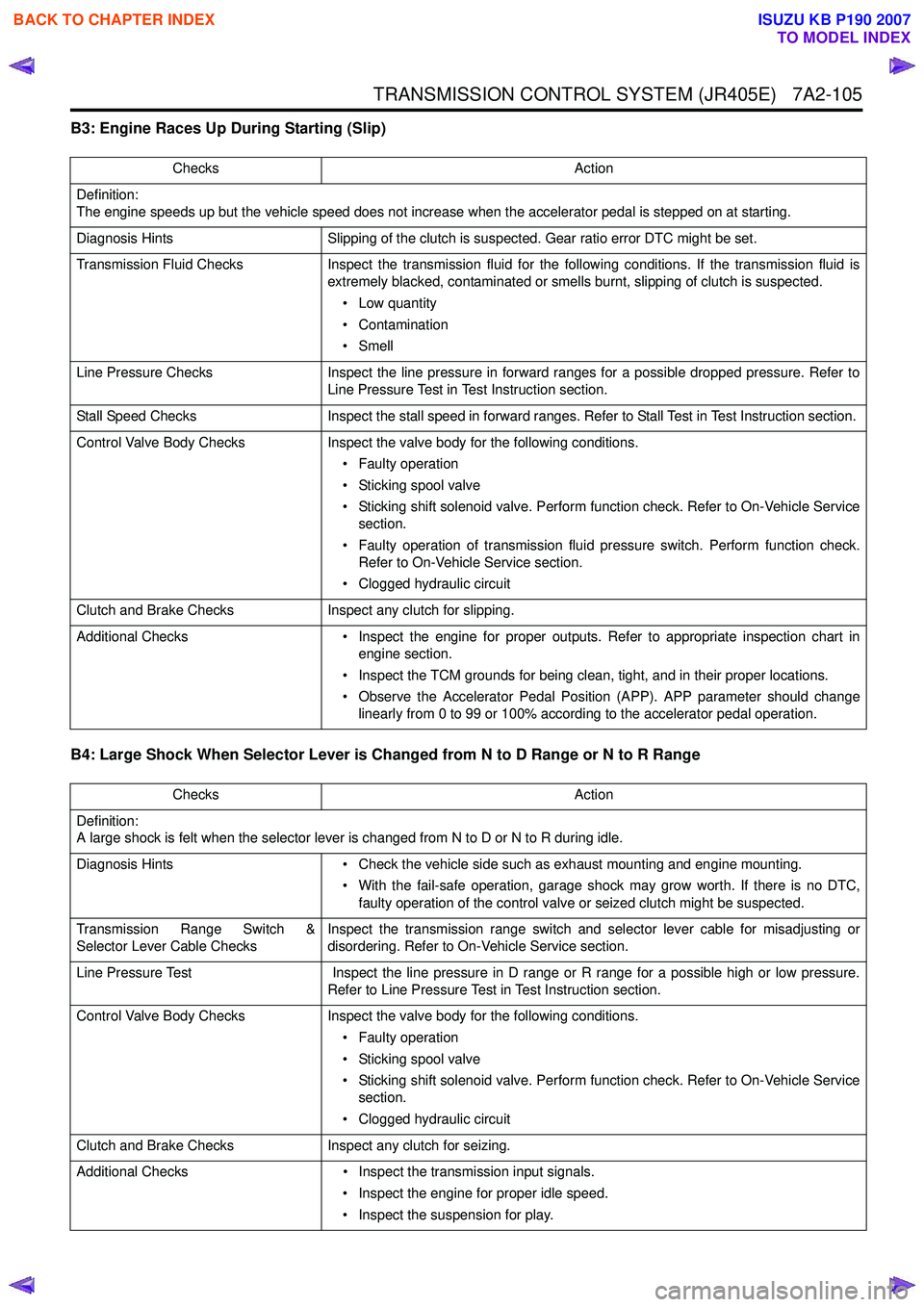
TRANSMISSION CONTROL SYSTEM (JR405E) 7A2-105
B3: Engine Races Up During Starting (Slip)
B4: Large Shock When Selector Lever is Changed from N to D Range or N to R Range
Checks Action
Definition:
The engine speeds up but the vehicle speed does not increase when the accelerator pedal is stepped on at starting.
Diagnosis Hints Slipping of the clutch is suspected. Gear ratio error DTC might be set.
Transmission Fluid Checks Inspect the transmission fluid for the following conditions. If the transmission fluid is
extremely blacked, contaminated or smells burnt, slipping of clutch is suspected.
• Low quantity
• Contamination
•Smell
Line Pressure Checks Inspect the line pressure in forward ranges for a possible dropped pressure. Refer to
Line Pressure Test in Test Instruction section.
Stall Speed Checks Inspect the stall speed in forward ranges. Refer to Stall Test in Test Instruction section.
Control Valve Body Checks Inspect the valve body for the following conditions.
• Faulty operation
• Sticking spool valve
• Sticking shift solenoid valve. Perform function check. Refer to On-Vehicle Service section.
• Faulty operation of transmission fluid pressure switch. Perform function check. Refer to On-Vehicle Service section.
• Clogged hydraulic circuit
Clutch and Brake Checks Inspect any clutch for slipping.
Additional Checks • Inspect the engine for proper outputs. Refer to appropriate inspection chart in
engine section.
• Inspect the TCM grounds for being clean, tight, and in their proper locations.
• Observe the Accelerator Pedal Position (APP). APP parameter should change linearly from 0 to 99 or 100% according to the accelerator pedal operation.
Checks Action
Definition:
A large shock is felt when the selector lever is changed from N to D or N to R during idle.
Diagnosis Hints • Check the vehicle side such as exhaust mounting and engine mounting.
• With the fail-safe operation, garage shock may grow worth. If there is no DTC, faulty operation of the control valve or seized clutch might be suspected.
Transmission Range Switch &
Selector Lever Cable Checks Inspect the transmission range switch and selector lever cable for misadjusting or
disordering. Refer to On-Vehicle Service section.
Line Pressure Test Inspect the line pressure in D range or R range for a possible high or low pressure.
Refer to Line Pressure Test in Test Instruction section.
Control Valve Body Checks Inspect the valve body for the following conditions.
• Faulty operation
• Sticking spool valve
• Sticking shift solenoid valve. Perform function check. Refer to On-Vehicle Service section.
• Clogged hydraulic circuit
Clutch and Brake Checks Inspect any clutch for seizing.
Additional Checks • Inspect the transmission input signals.
• Inspect the engine for proper idle speed.
• Inspect the suspension for play.
BACK TO CHAPTER INDEX
TO MODEL INDEX
ISUZU KB P190 2007
Page 4390 of 6020
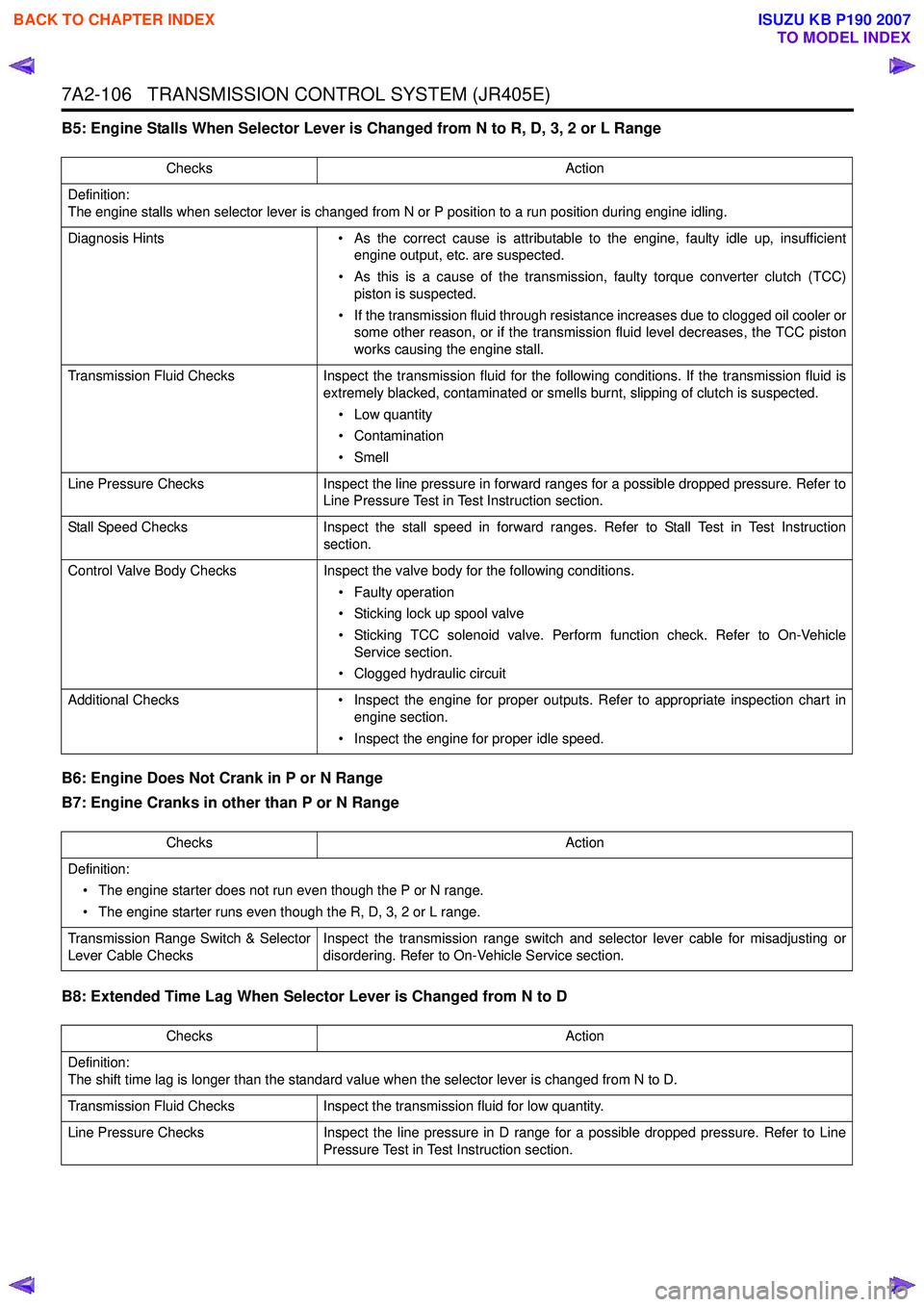
7A2-106 TRANSMISSION CONTROL SYSTEM (JR405E)
B5: Engine Stalls When Selector Lever is Changed from N to R, D, 3, 2 or L Range
B6: Engine Does Not Crank in P or N Range
B7: Engine Cranks in other than P or N Range
B8: Extended Time Lag When Selector Lever is Changed from N to D
Checks Action
Definition:
The engine stalls when selector lever is changed from N or P position to a run position during engine idling.
Diagnosis Hints • As the correct cause is attributable to the engine, faulty idle up, insufficient
engine output, etc. are suspected.
• As this is a cause of the transmission, faulty torque converter clutch (TCC) piston is suspected.
• If the transmission fluid through resistance increases due to clogged oil cooler or some other reason, or if the transmission fluid level decreases, the TCC piston
works causing the engine stall.
Transmission Fluid Checks Inspect the transmission fluid for the following conditions. If the transmission fluid is
extremely blacked, contaminated or smells burnt, slipping of clutch is suspected.
• Low quantity
• Contamination
• Smell
Line Pressure Checks Inspect the line pressure in forward ranges for a possible dropped pressure. Refer to
Line Pressure Test in Test Instruction section.
Stall Speed Checks Inspect the stall speed in forward ranges. Refer to Stall Test in Test Instruction
section.
Control Valve Body Checks Inspect the valve body for the following conditions.
• Faulty operation
• Sticking lock up spool valve
• Sticking TCC solenoid valve. Perform function check. Refer to On-Vehicle Service section.
• Clogged hydraulic circuit
Additional Checks • Inspect the engine for proper outputs. Refer to appropriate inspection chart in
engine section.
• Inspect the engine for proper idle speed.
Checks Action
Definition: • The engine starter does not run even though the P or N range.
• The engine starter runs even though the R, D, 3, 2 or L range.
Transmission Range Switch & Selector
Lever Cable Checks Inspect the transmission range switch and selector lever cable for misadjusting or
disordering. Refer to On-Vehicle Service section.
Checks Action
Definition:
The shift time lag is longer than the standard value when the selector lever is changed from N to D.
Transmission Fluid Checks Inspect the transmission fluid for low quantity.
Line Pressure Checks Inspect the line pressure in D range for a possible dropped pressure. Refer to Line
Pressure Test in Test Instruction section.
BACK TO CHAPTER INDEX
TO MODEL INDEX
ISUZU KB P190 2007
Page 4391 of 6020

TRANSMISSION CONTROL SYSTEM (JR405E) 7A2-107
B9: Extended Time Lag When Selector Lever is Changed from N to R
B10: Brake is Applied in R Range
B11: Insufficient Starting or Shaking in D Range
Control Valve Body Checks Inspect the valve body for the following conditions.
• Faulty operation
• Sticking spool valve
• Clogged hydraulic circuit
Clutch and Brake Checks Inspect the low clutch and low one-way clutch for slipping.
Solenoid Valve Checks • Inspect the low clutch solenoid valve for faulty operation.
Checks Action
Definition:
The shift time lag is longer than the standard value when the selector lever is changed from N to R.
Transmission Fluid Checks Inspect the transmission fluid for low quantity.
Line Pressure Checks Inspect the line pressure in R range for a possible dropped pressure. Refer to Line
Pressure Test in Test Instruction section.
Control Valve Body Checks Inspect the valve body for the following conditions.
• Faulty operation
• Sticking spool valve
• Clogged hydraulic circuit
Clutch and Brake Checks Inspect the low & reverse brake for slipping.
Solenoid Valve Checks • Inspect the low & reverse brake solenoid valve for faulty operation.
Checks
Action
Checks Action
Definition:
Brake is applied suddenly in R range.
Diagnosis Hints Trouble in transmission main unit is suspected. The trouble in the transmission main
unit may originate from the input circuits or output circuits; these circuits should also
be checked to prevent a reoccurrence of the trouble.
Transmission Range Switch & Selector
Lever Cable Checks Inspect the transmission range switch and selector lever cable for misadjusting or
disordering. Refer to On-Vehicle Service section.
Transmission Fluid Checks Inspect the transmission fluid for low quantity.
Control Valve Body Checks Inspect the valve body for the following conditions.
• Faulty operation
• Sticking spool valve
• Clogged hydraulic circuit
Clutch and Brake Checks Inspect the low clutch, high clutch or 2-4 brake for seizing.
Additional Checks • Inspect the parking mechanism for faulty operation.
Checks Action
Definition:
Insufficient starting or shaking in D range.
Transmission Fluid Checks Inspect the transmission fluid for low quantity.
Line Pressure Checks Inspect the line pressure in D range for a possible dropped pressure. Refer to Line
Pressure Test in Test Instruction section.
BACK TO CHAPTER INDEX
TO MODEL INDEX
ISUZU KB P190 2007